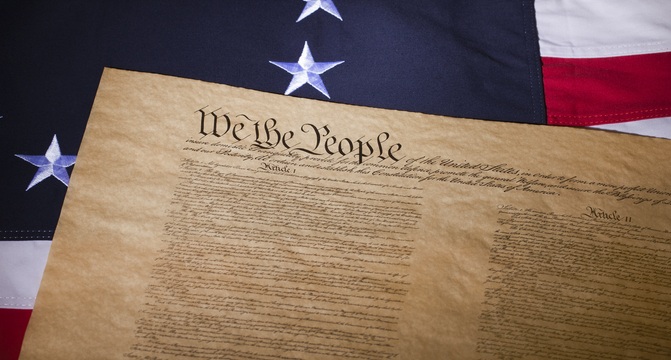One of the two most important pro-life bills in the country is the Life at Conception Act, which would theoretically overturn Roe v. Wade by a simple congressional vote and president’s signature, rather than by waiting to overturn it through a future Supreme Court case or federal constitutional amendment (both extremely uncertain and burdensome options).
Unfortunately, the LCA currently doesn’t receive nearly the amount of attention and support it deserves, even from pro-lifers—a situation that isn’t helped by pieces like Lyle Denniston’s at the National Constitution Center, which supposedly debunks the LCA’s viability. So let’s look at why pro-lifers shouldn’t let his erroneous critique discourage us from fighting for the most viable means of changing the abortion battle’s status quo.
First, the author gets the basic summary of how the LCA works correct:
[Section 5 of the 14th Amendment] gives Congress “power to enforce by appropriate legislation, the provisions of this article.” Among the protections that the amendment assures is a prohibition on state laws that would “deprive any person of life.” Senate bill S. 2464 seeks to define “life” to include fetal life, at all stages of pregnancy […]
Justice [Harry] Blackmun wrote [in Roe] that the court did not need to settle “the difficult question of when life begins.” And the senator then turns to another passage in which Blackmun said that, if the court were to accept that “person” under the Fourteenth Amendment meant a fetus, at all stages of development, that would mean that a claim to a right to abortion “collapses” because “the fetus’ right to life is then guaranteed specifically by the Amendment.”
However, Denniston goes on to list several allegedly fatal errors with that theory:
The Blackmun opinion drew a distinction between “when life begins,” which the court was not attempting to decide, and whether a fetus is a “person” under the Amendment, which the court did, in fact, decide. Indeed, the opinion says flatly that “the word ‘person,’ as used in the Fourteenth Amendment, does not include the unborn.”
Two things: first, lawmakers are not obligated to indulge the delusion that a human life and a person are two different things, even if Supreme Court justices are among those who’ve fallen for it. Scientific and philosophical questions are not matters of constitutional interpretation for which a legal background bestows special knowledge. Ultimately, though, the fact remains that Roe itself unlocked the door the LCA opens: if they’re people, they have a right to life. They are people, so there you have it.
Second, past justices’ interpretation of a text is inherently less authoritative than the understanding of the text’s own authors. The Fourteenth Amendment’s primary drafter, John Bingham, said it applied to “any human being.” Going further back, when the Founding Fathers drafted, signed, and ratified the Declaration of Independence and the Constitution, they were operating from the teachings of leading legal authorities William Blackstone and James Wilson, who expressly taught that the right to life began before birth.
The opinion also noted that the state of Texas, in urging the court to include a fetus as a constitutionally protected “person,” had conceded that no court ruling could be cited in support of that idea.
Why was there no such precedent? Probably because there wasn’t much need to drag it into court before. In the late Justice William Rehnquist’s dissent from Roe, he noted:
As early as 1821, the first state law dealing directly with abortion was enacted by the Connecticut Legislature. Conn.Stat., Tit. 22, §§ 14, 16. By the time of the adoption of the Fourteenth [p175] Amendment in 1868, there were at least 36 laws enacted by state or territorial legislatures limiting abortion. [n1] While many States have amended or updated [p176] their laws, 21 of the laws on the books in 1868 remain in effect today. [n2] Indeed, the Texas statute struck down today was, as the majority notes, first enacted in 1857, [p177] and “has remained substantially unchanged to the present time.” Ante at 119.
In his later dissent in Planned Parenthood v. Casey, Rehnquist added that the “common law which we inherited from England made abortion after ‘quickening’ an offense,” and “[b]y the turn of the century virtually every State had a law prohibiting or restricting abortion on its books.”
Denniston continues:
Blackmun ran through the other parts of the Constitution where the word “person” is used, and commented that none of those “indicates, with any assurance, that it has possible pre-natal application.”
So, so wrong. We know for an irrefutable biological fact that the preborn are human beings at every stage. So unless Mr. Denniston wants to open another can of worms by suggesting there is any other category of living humans the Constitution shouldn’t recognize as persons, that means the preborn get the presumption of personhood, too. This idea that any class of humans needs some separate proof of personhood is exactly backwards; the real burden of proof should be on those who want to exclude anyone from the human family.
Beyond Roe v. Wade itself, the Life at Conception Act appears to run up against a constitutional principle that the Supreme Court declared in a 1997 decision in the case of City of Boerne v. Flores. That is the ruling in which the Justices ruled that a federal law, the Religious Freedom Restoration Act, could not constitutionally be applied to restrict state and local governments’ power to regulate at least some aspects of religious organizations’ activity.
There’s one major problem with Denniston’s theory here: the LCA doesn’t compel state and local governments to ban abortion; it frees them to. It isn’t a direct abortion ban, but simply a restoration of the states’ (and the people’s) right to decide abortion policy for themselves. So it doesn’t run afoul of the principles at issue in Boerne.
The most important part of that ruling, as it applies to attempts to protect fetal life under the Fourteenth Amendment, is that the court declared that Congress simply does not have the power – under the enforcement provision in Section 5 of the Amendment – to redefine a constitutional right that has been spelled out by the courts. “Congress does not enforce a constitutional right by changing what the right is,” the court said.
The Supreme Court claiming for itself a monopoly on interpreting constitutional rights doesn’t make it so. In fact, the three branches have a coequal power and responsibility to protect the Constitution as they understand it—from each other, if necessary. As Thomas Jefferson said in 1815, “there is not a word in the Constitution which has given” more “authority to decide on the constitutionality of a law” than that given “to the Executive or Legislative branches.”
The definition of what rights exist under the Constitution, it stressed, is the task of the judiciary.
Even if we granted that, the LCA doesn’t define a new right. The right to life is already spelled out in the Constitution and the courts already acknowledge it; all the LCA does is recognize the scientific fact that fetuses are members of the category covered by this right. If a SCOTUS ruling claimed day was night, would lawmakers be obligated to pretend that was the case until the Court changed its mind?
The court has been claiming that exclusive power of interpretation ever since 1803, and the decision in Marbury v. Madison.
Actually, Ethics & Public Policy Center president and legal expert Edward Whelan points out that what Chief Justice John Marshall actually claimed in Marbury was decidedly less all-encompassing: when conflicting rules force SCOTUS to “either decide that case conformably to the law, disregarding the constitution; or conformably to the constitution, disregarding the law,” it “must determine which of these conflicting rules governs the case.” In other words, judicial review is merely a tool for ensuring that the Constitution trumps unconstitutional statutes. This in no way says the judiciary’s conclusions are infallible or that the other branches have to play along when the judiciary abuses the Constitution.
That even an organization called the National Constitution Center has succumbed to this elevation of the judiciary above the Constitution the judiciary is there to serve should be all the more reason to champion the Life at Conception Act—not only to save preborn lives, but also to take a real step toward restoring the rule of law and our system of checks and balances that makes it work.







